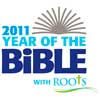In 2011 many people and organisations are celebrating the 400th anniversary of the King James translation of the Bible, and ROOTS is joining in, providing a range of additional materials that you can use to supplement the usual weekly material in order to mark the anniversary. Here, introducing the series, Frank Field MP, Chairman of the 2011 Trust explains what maes 2011 important.
Frank Field MP, Chairman of the 2011 Trust, explains what makes 2011 the Year of the Bible. 
The next time you open your Bible, choose some of your favourite verses, and then try to imagine this: you have become a criminal simply for reading those words in English. Not only that, but if you’re caught, you could be burnt at the stake.
It sounds unbelievable, doesn’t it? But that’s what worship was like in England 500 years ago. You were only allowed to hear Scripture read to you by a priest – in Latin! This changed only when a very brave and brilliant priest called William Tyndale decided to defy the king and the bishops and translate the Bible into beautiful, clear English. Tyndale even told a bishop that the ‘simplest ploughboy’ would soon be able to understand God’s word better than the clergy.
Tyndale had to flee to Europe and work in hiding, but in 1535 Henry VIII’s agents finally caught up with him, and the following year he was burnt at the stake. Yet within months Henry changed his mind and decided he did want an English Bible after all, for the new Church of England created after he divorced his first wife and broke with Rome.
Many more versions of the Bible followed, all based on Tyndale’s work. By the time James VI of Scotland succeeded Henry’s daughter Elizabeth to become James I, we had the Bishops’ Bible, the Geneva Bible, the Great Bible and the Matthew Bible among others. So at a great meeting at Hampton Court in 1604, James asked 54 leading churchmen and scholars to form committees and come up with a definitive version. These men took the best of the previous translations, but gave them added beauty, and 400 years ago, in 1611, the King James Bible was born.
Now Britain had an ‘official’ Bible – which is why the King James Bible also came to be known as the Authorised Version. It was the end of a turbulent 80-year saga – but it was also the beginning of another story, the journey of the King James Bible around the world. This was the translation read by American slaves as they struggled for freedom, and you can still detect its influence in the speeches of President Obama.
When you first look at a King James Bible, it can seem a bit daunting, with all its ‘thees’, ‘thous’ and ‘haths’. My tip? Read it out loud, because the translators designed their Bible to be heard. Take a famous line from Psalm 23:
’Yea, though I walk through the valley of the shadow of death, I will fear no evil.’
It has a beautiful rhythm, almost a pulse, running through it. Perhaps that’s why the American rap star Coolio used it in his song ‘Gangsta’s Paradise’. I wonder if King James would have approved of that!
So why not go back to your favourite verses, see what they sounded like in 1611, and perhaps offer up a prayer of gratitude to the translators who allowed us not just to have a Bible in English, but a Bible that helped English become a language for the world.
You can find out more about the Year of the Bible on the website http://www.2011trust.org/
 Go to index of all ROOTS
Go to index of all ROOTS
Year of the Bible 2011 material